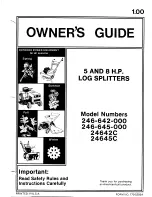
-22-
Model T32305 (Mfd. Since 08/20)
Splitting Wedge
During the life of your log splitter, you will need
to sharpen the splitting wedge periodically. When
sharpening the wedge, keep in mind that if you
try to sharpen it too much (like a knife blade),
you will greatly reduce the life of the wedge by
always sharpening it. However, if you allow the
point to become very dull or bullnosed, your log
splitter will have to overwork to split logs, which
will decrease the lifespan of the splitter. The
optimum point is somewhere between. Refer to
Figure 19 for a general idea.
To reduce risk of serious
cuts, always wear leather
gloves when sharpening
splitting wedge.
Wedge Too Sharp
Wedge Too Dull
Wedge Just Right
Figure 19. Wedge points.
1. DISCONNECT MACHINE FROM POWER!
2. Put on safety glasses and latex gloves.
3. Place drain pan under hydraulic fluid tank
plug.
4. Turn air bleed screw counterclockwise two
full turns (see
Figure 18).
5. Remove hydraulic fluid tank plug, as shown
in
Figure 18, and raise motor end of splitter
to ensure hydraulic tank drains completely.
6. When tank is empty, turn air bleed screw
clockwise until it stops.
7. Use transport handle to position log splitter
vertically (see
Figure 16 on Page 21).
8. Fill tank with 3.6 quarts of hydraulic fluid and
re-install plug.
9. Check hydraulic fluid level.
IMPORTANT: Be sure to dispose of old
hydraulic fluid according to federal, state, and
fluid manufacturer's requirements.
Change Hydraulic Fluid
Changing Hydraulic Fluid
Figure 18. Location of components to drain
hydraulic fluid tank.
Air Bleed
Screw
Hydraulic Fluid
Tank Plug













































